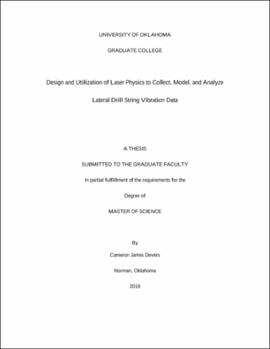| dc.contributor.advisor | Teodoriu, Catalin | |
| dc.contributor.author | Devers, Cameron | |
| dc.date.accessioned | 2020-05-08T21:48:44Z | |
| dc.date.available | 2020-05-08T21:48:44Z | |
| dc.date.issued | 2020-05 | |
| dc.identifier.uri | https://hdl.handle.net/11244/324354 | |
| dc.description.abstract | This study focuses on measuring lateral drill string vibrations. First, the nature of drill string vibrations is discussed. Second, a review of previous experiments on drill string vibrations, both in the laboratory and field, is presented to highlight previous successes and potential improvements to be made in future research. The conclusion from the review of previous works is that historical methods of collecting data greatly restricted access to drill string vibration measurements, did not collect data at a high enough resolution, nor collected comprehensive data. This conclusion became the basis for the experimental design outlined in the document, with significant work performed to determine the best method of measuring and collecting drill string lateral vibration data. The method selected was incorporated into the drill string experimental model at multiple points along the drill string. A method of calibration was designed and incorporated to ensure the data collected from the model was accurate. An initial test was done to generate data needed to format a robust testing method. Results from the initial test indicated data needed to be primarily collected at high rotational speeds and sampled at 1 kHz for comprehensive data collection. Data was also down-sampled to 100 Hz and 10 Hz in order to study what information is lost at lower resolutions. Experiments were run at five rotary speeds at constant WOB with data sampled at 1 kHz, 100 Hz, and 10 Hz. Initial analysis of the tests verify large amounts of pattern-recognizable data is lost as sampling frequency decreases. Additionally, previous assumptions regarding the circular rotational patterns of the drill string when not constrained are brought into question as evidence suggests significant deformation of regular oscillatory patterns along the drill string during the onset of lateral vibrations. Lastly, Fast Fourier Transform (FFT) analysis concluded that there is substantial information aliased moving from 100 Hz to 10 Hz, with minor aliasing happening moving from 1 kHz to 100 Hz. | en_US |
| dc.language | en_US | en_US |
| dc.subject | Drilling | en_US |
| dc.subject | Vibration | en_US |
| dc.subject | Petroleum | en_US |
| dc.subject | Drill String | en_US |
| dc.subject.lcsh | Drilling and boring machinery | |
| dc.subject.lcsh | Oil well drilling--Equipment and supplies | |
| dc.subject.lcsh | Gas well drilling--Equipment and supplies | |
| dc.subject.lcsh | Vibration | |
| dc.title | Design and Utilization of Laser Physics to Collect, Model, and Analyze Lateral Drill String Vibration Data | en_US |
| dc.contributor.committeeMember | Ahmed, Ramadan | |
| dc.contributor.committeeMember | Devegowda, Deepak | |
| dc.date.manuscript | 2020-05-08 | |
| dc.thesis.degree | Master of Science | en_US |
| ou.group | Mewbourne College of Earth and Energy::Mewbourne School of Petroleum and Geological Engineering | en_US |
| shareok.orcid | https://orcid.org/0000-0002-5505-487X | en_US |
